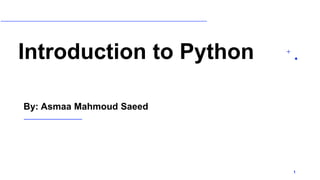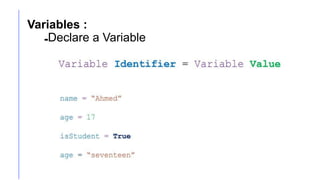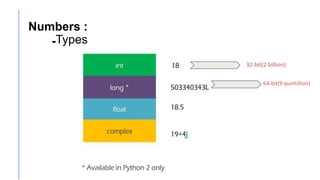Introduction to Python_for_machine_learning.pdf
- 1. Introduction to Python 1 By: Asmaa Mahmoud Saeed
- 2. Asmaa Mahmoud Saeed ITI • • MSc, Computer Science •AAST Bachelor of Science , Menoufia University • Computer Science 2 https://www.linkedin.com/in/asmaa-m-491750194/ [email protected] Contact me
- 3. Sessions Content Introduction to Python Working with files Data types, Working with Data Structure 5 S1 S2 S3 S4 s5 Conditional statement- Looping and iteration S5 Python Modules and Libraries
- 4. Introduction The session is designed to learn how to use one of the best programming language for different applications, like: 3 Python Machine learning web Application Data Science network servers -Rank of Python (5) in 2020
- 5. Python
- 6. Tools and Environment setup 1. Google colab https://colab.research.google.com/
- 7. Tools and Environment setup 1. Anaconda https://www.anaconda.com/download Recommended(Python 3.12)
- 8. Tools and Environment setup
- 9. Tools and Environment setup
- 10. Tools and Environment setup
- 11. Tools and Environment setup Jupyter Notebook Jupyter Lab
- 12. Basic I/P and O/P Operation : O/P Function : •Print to the screen what you write ! Hello world
- 13. Basic I/P and O/P Operation : I/P Function : •It always reads the input as a string •Two ways to use it: •input() which reads directly •input(msg) which prints a message first
- 14. Topics Hands-on (I) •Syntax,Reserved words,Line Identiation ,comment. •Conditions and Loops •Lists, Tuples , Dictionaries •OOP and Classes Component •Arithmetics, Assignment, Comparison, Logic Gates Python Syntax Rules Variables & Data Types Operators Data Structures Control Flow Functions Classes List Comprehension & Lambda File Handling in Python Python is loosely typed language
- 15. Syntax: Python Identifier:a name used to identify a Case Sensitive Variable function,class, module or other object Python is Language
- 16. Reserved Words : -A Python identifier doesn’t be one of Reserved words
- 18. Quotes … 1.. 2 ... 3 :
- 19. Comments :
- 20. Variables : -Declare a Variable
- 21. Data Types : NaN (Not a Number): NaN represents missing or undefined data in Python.
- 22. Data Types : -Type conversion
- 26. Boolean Operators : -Logic Gates
- 27. Boolean Operators : -Logic Gates
- 28. Strings:
- 31. Numbers : -Types 32-bit(2 billion) 64-bit(9 quintillion)
- 33. Numbers : -Methods R = max(x,y)
- 34. Data Structures: -Lists : Container for heterogeneous Data Type =list()
- 40. Data Structures: Sets: Set items are unordered, unchangeable, and do not allow duplicate values. Unordered Unordered means that the items in a set do not have a defined order. Set items can appear in a different order every time you use them, and cannot be referred to by index or key Unchangeable Set items are unchangeable, meaning that we cannot change the items after the set has been created. Duplicates Not Allowed Sets cannot have two items with the same value.
- 44. Control Flow: - Conditions: IF Statement
- 45. Control Flow: - Loops: for..in s s
- 46. Control Flow: - Loops: Range Function
- 47. Control Flow: - Loops: While
- 48. Control Flow: - Loops: Break Statement
- 49. Control Flow: - Loops: Continue Statement
- 50. Control Flow: - Loops: Else Statement
- 51. Control Flow: - Loops: Pass Statement
- 52. Functions:
- 55. Functions: *arguments (unknown No Of argument)
- 56. Functions: **keywords (unknown No Of Keywords)
- 58. Why OOP?:
- 59. Motivation: •Imagine we are creating a system for a company •It has many departments Each department has employees •Each employee has information: name, age, address, salary, etc •And much more information and relationships
- 60. Motivation:
- 61. (OOP KeyWords): Class: •Example class Company: pass •A class is a template definition of an object's properties and methods.
- 62. (OOP KeyWords): Object: • Example comp=Company() An Object is an instance on a Class.
- 63. (OOP KeyWords): Constructor: Constructor is a method called at the moment an object is instantiated. Example : :
- 64. (OOP KeyWords): Instance variables: is an object characteristic, such as name.
- 65. (OOP KeyWords): Class variables: is the variable that shared by all instances.
- 66. (OOP KeyWords): Instance Method: is an object capability, such as walk.
- 67. (OOP KeyWords): Class Method: is a method that shared by all instances of the Class
- 68. (OOP KeyWords): : Static Method is a normal function that have logic that related to the Class
- 70. Practical Examples (I) Let’s open the following notebook: Notebook Name: python basics.ipynb 70
- 71. List Comprehension & Lambda Fn : Lambda Function:
- 72. File Handling : - Opening File : Text(.txt,.c,.cpp) ,Json file, CSV
- 73. File Handling : Mix reading and writing:
- 74. File Handling : -Closing File :
- 75. File Handling : Reading : open, read and close
- 76. File Handling : Reading: Reading Line :read all the file content!
- 77. File Handling : Reading: .read().splitlines
- 78. File Handling : Writing: The write method doesn’t add new line. If you want it, you have to provide it By default, the old content will be overwritten
- 79. File Handling : Writing: PrintLines: Just add n to force print new line
- 80. File Handling : Writing: Appending mode: ●The append mode just keep adding things to the end of the file • Each run will add new content, not overwriting
- 82. Modules Module: A module is a file that contains code to perform a specific task. A module may contain variables, functions, classes etc Module types : 1-Built-in Module : Python built-in modules are a set of libraries that come pre-installed with the Python installation Examples: math,time,random,…etc. 2-External modules: External modules are collections of pre-written code that offer additional functions, classes, or methods not available in Python's standard library. Examples: Numpy,pandas,Matplotlib…etc.
- 83. Python math Module 1.Python has a built-in module that you can use for mathematical tasks. 2. The math module has a set of methods and constant. 3. The math module gives us access to hyperbolic , trignometric , and logarithmic functions for real numbers and cmath module allows us to work with mathematical functions
- 84. Arithmetic Functions These functions perform various arithmetic operations like calculating the floor, ceiling, or absolute value of a number using the floor(x), ceil(x), and fabs(x) functions respectively. The function ceil(x) will return the smallest integer that is greater than or equal to x. Similarly, floor(x) returns the largest integer less than or equal to x. The fabs(x) function returns the absolute value of x. You can also perform non-trivial operations like calculating the factorial of a number using factorial(x)
- 86. Trigonometric Functions You can calculate sin(x), cos(x), and tan(x) directly using this module. However, there is no direct formula to calculate cosec(x), sec(x), and cot(x), but their value is equal to the reciprocal of the value returned by sin(x), cos(x), and tan(x) respectively
- 88. Hyperbolic functions Hyperbolic functions are analogs of trigonometric functions that are based on a hyperbola instead of a circle. In trigonometry, the points (cos b, sin b) represent the points of a unit circle. In the case of hyperbolic functions, the points (cosh b, sinh b) represent the points that form the right half of an equilateral hyperbola. Just like the trigonometric functions, you can calculate the value of sinh(x), cosh(x), and tanh(x) directly. The rest of the values can be calculated using various relations among these three values. There are also other functions like asinh(x), acosh(x), and atanh(x), which can be used to calculate the inverse of the corresponding hyperbolic values
- 90. Time Functions in Python What is Tick? Time intervals are floating-point numbers in units of seconds. Particular instants in time are expressed in seconds since 00:00:00 hrs January 1, 1970(epoch). There is a popular time module available in Python which provides functions for working with times, and for converting between representations. The function time.time() returns the current system time in ticks since 00:00:00 hrs January 1, 1970(epoch). Epoch:- a particular period of time in history or a person's life
- 91. Time Functions in Python • gmtime(sec) :- This function returns a structure with 9 values each representing a time attribute in sequence. It converts seconds into time attributes(days, years, months etc.) till specified seconds from epoch. If no seconds are mentioned, time is calculated till present. • asctime(“time”) :- This function takes a time attributed string produced by gmtime() and returns a 24 character string denoting time. • ctime(sec) :- This function returns a 24 character time string but takes seconds as argument and computes time till mentioned seconds. If no argument is passed, time is calculated till present. • sleep(sec) :- This method is used to halt the program execution for the time specified in the arguments
- 92. Python Datetime Module A date in Python is not a data type of its own, but we can import a module named datetime to work with dates as date objects. Example: Import the datetime module and display the current date:
- 93. Python Random Module Python Random module is an in-built module of Python which is used to generate random numbers. These are pseudo-random numbers means these are not truly random. This module can be used to perform random actions such as generating random numbers, print random a value for a list or string, etc. Example: Printing a random value from a list
- 94. Python Random Module he randrange() method returns a randomly selected element from the specified range. Syntax random.randrange(start, stop, step) Return number between 3(included) and 9 (not included )
- 95. Python Packages Suppose you have developed a very large application that includes many modules. As the number of modules grows, it becomes difficult to keep track of them all if they are dumped into one location. This is particularly so if they have similar names or functionality. You might wish for a means of grouping and organizing them. Packages allow for a hierarchical structuring of the module namespace using dot notation. In the same way that modules help avoid collisions between global variable names, packages help avoid collisions between module names. Creating a package is quite straightforward, since it makes use of the operating system’s inherent hierarchical file structure. Consider the following arrangement: In the same way, a package in Python takes the concept of the modular approach to next logical level. As you know, a module can contain multiple objects, such as classes, functions, etc. A package can contain one or more relevant modules. Physically, a package is actually a folder containing one or more module files
- 96. External Modules What are External Modules? External modules are collections of pre-written code that offer additional functions, classes, or methods not available in Python's standard library List of Most Popular Python External Modules Data Analysis and Manipulation: •pandas: Provides high-performance, easy-to-use data structures and data analysis tools. •numpy: Fundamental package for numerical computations in Python.
- 97. External Modules Machine Learning and Artificial Intelligence: •scikit-learn: Machine learning library featuring various algorithms and tools. •TensorFlow: Open-source machine learning framework developed by Google. •PyTorch: An open-source deep learning platform by Facebook. 4. Data Visualization: •matplotlib: Comprehensive library for creating static, animated, and interactive visualizations. •seaborn: Data visualization library based on matplotlib; provides a higher-level interface for drawing attractive and informative statistical graphics. 5. Web Scraping: •BeautifulSoup: Library for pulling data out of HTML and XML documents. •Scrapy: An open-source and collaborative web crawling framework.
- 98. Using External Modules Pip install module_name Example
- 100. Practical Examples (I) Let’s open the following notebook: Notebook Name: File_Handling.ipynb 70
- 101. References •Python Tutorial | Learn Python Programming - GeeksforGeeks •Python Tutorial (tutorialspoint.com https://www.w3schools.com/Python/module_statistics.asp https://www.w3schools.com/python 11 0
- 102. THANK YOU!



































































































































![Language Learning App Data Research by Globibo [2025]](https://cdn.slidesharecdn.com/ss_thumbnails/languagelearningapps2025-250515071223-23cd4bbe-thumbnail.jpg?width=560&fit=bounds)



